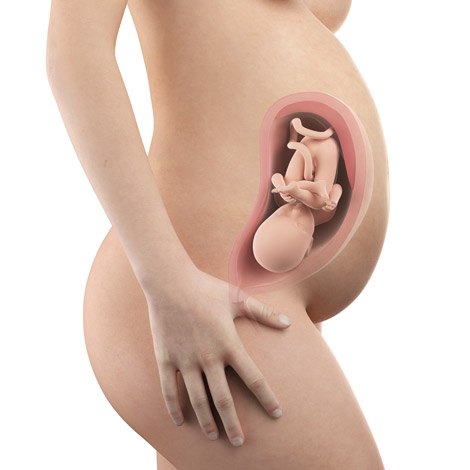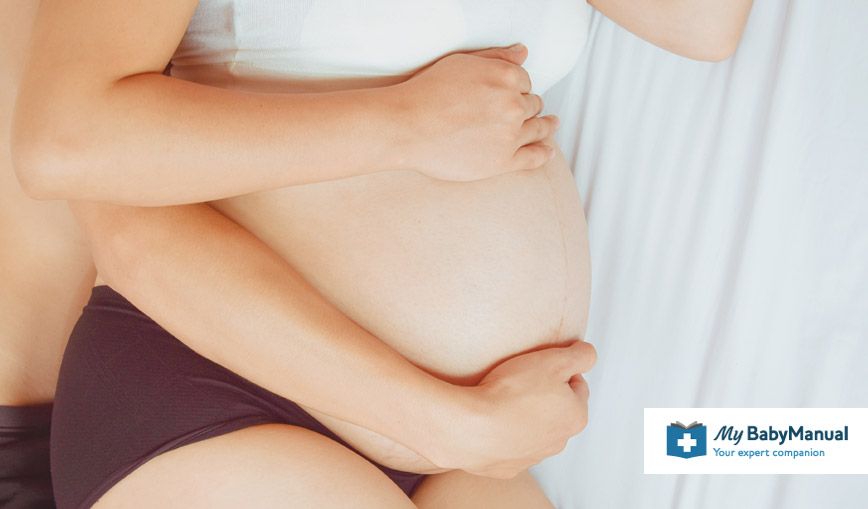Your baby this week
POUNDS IN WEIGHT
Your baby's skin is becoming softer and smoother.
Your baby’s hair is gradually getting thicker.
Your baby is now likely to be full of energy.
How big is your baby?
Putting on more weight each week, your baby has now reached 1.7kg (3 lb 6 oz). He measures about 42.4cm from head to toe.

How big is your baby?
Putting on more weight each week, your baby has now reached 1.7kg (3 lb 6 oz). He measures about 42.4cm from head to toe.

What does your baby look like?
He is continuing to gain fat, with skin becoming softer and smoother. Although he may have lost the fine hair covering his body (lanugo), he now could have hair on his head that is gradually getting thicker. These will eventually develop into lovely flowing locks once he’s been born.
Changes in your body this week
Your blood volume has increased by 40 to 50 per cent throughout your pregnancy, which can make you feel warm (and may possibly make you feel slightly faint).
Your expanding baby is continuing to put pressure on your diaphragm and stomach, which is likely to cause shortness of breath as well as heartburn.
How your baby is developing
Your baby is now likely to be full of energy, and may become the most active when you relax. He will be kicking a lot. You should think about recording your baby’s kicks, as it’s important to know his movement pattern.
According to Kicks Count, an organisation set up to educate parents-to-be on their baby’s movements, there is no specific number of kicks that you should be counting, as every child is different.

How your baby is developing
Your baby is now likely to be full of energy, and may become the most active when you relax. He will be kicking a lot. You should think about recording your baby’s kicks, as it’s important to know his movement pattern. According to Kicks Count, an organisation set up to educate parents-to-be on their baby’s movements, there is no specific number of kicks that you should be counting, as every child is different.

So get to know your child’s “normal” number, and if you ever get concerned that the movements are less frequent, call your midwife or doctor.
Health concerns
Varicose veins, which are large swollen blood vessels, are a common symptom from week 29 onwards, and you may have encountered them by now. They are harmless to you and your baby, yet they can be uncomfortable.
To prevent your varicose veins from getting worse, remember to eat as healthily as possible (which means avoiding processed foods) and drink plenty of water. Doing a light form of exercise daily and avoiding staying still for long periods of time will help keep your blood circulation flowing well and stop the varicose veins from getting larger. The good news is that they should go down a few months after giving birth. If they don’t, you have the option of having them surgically removed.
You may also be experiencing hunger pangs in the third trimester because your body requires a slightly larger calorie intake than in your first two trimesters, and so your appetite increases. Your hunger keep you up at night, and you may be tempted to snack on unhealthy food. If you do feel the urge to nibble, try to keep your food choices healthy. Fresh fruit and vegetables or a slice of wholegrain toast are always great choices. But avoid citrus fruits and spicy foods if you struggle with indigestion.
Are there any symptoms you should be looking out for?
Towards the end of your pregnancy, it is normal for the amount of your vaginal discharge to increase.
While increased vaginal discharge is normal at this stage, it’s still important you remain watchful for anything out of the ordinary. Be wary of the discharge smelling unpleasant, having an unusual colour (such as yellow or green), or being accompanied by itchiness and soreness. If there seems to be an unusual amount of discharge, or if you notice discharge that is tinged with blood, then it could be a sign of preterm labour, and you’ll need to call your doctor as soon as possible.
Safety first
As your bump gets bigger in the third trimester, you may find certain sex positions very uncomfortable. The missionary position is likely to be impossible now, so you may have to experiment with other positions. When doing so, always make sure you listen to your body and don’t try anything that results in pain. Sexual intimacy is meant to be enjoyable, after all. Good choices for the third trimester include the spoons position, where you and your partner lay side-by-side, and positions where you are on top, as these don’t put any weight on your uterus and allow you to control the pace.
While in most normal pregnancies it’s safe to continue to have sex until the baby is born, there are still some warning signs to be mindful of. Be prepared to stop if, for instance, you experience abdominal pain and cramping or if you notice vaginal bleeding.

Important issues this week
The majority of babies are positioned with their head down at full term, so the largest part, the head, comes out first. Around 32 to 34 weeks most babies move into this position. When a baby is born bottom or feet first, it is known as a breech birth.
A caesarean delivery may be the best option if a baby is bottom down. According to NCT, there are still some hospitals who will deliver breech babies vaginally, but there are numerous associated risks and the decision will depend on your individual case.
Most babies will turn head down as they near the end of gestation, but, if not, there is a procedure to try to manually turn the baby if it is still in the breech position at 37 weeks. For now though, don’t worry if your baby is still head up in your uterus, there’s still time for him to turn.
Keeping fit, staying healthy
You can try various techniques to help alleviate breathlessness, which is likely to be becoming more of a problem as your baby gets bigger and continues to put pressure on your diaphragm. In general, yoga is great for helping treat this issue, as it will help you control your breathing, and it will also help your posture (important for proper breathing).
But there are also some other, really simple things you can do at home. To help relieve the pressure your baby is putting on your diaphragm, try sitting in a position where your back is straight with your chest lifted and shoulders back. You can sit against a wall to help you keep your back straight. Try getting in this position to perform your controlled breathing exercises. Standing with straight posture should also help to ease your breathlessness.
Many women find that their breathing is often worse at night. To help, try propping yourself up with some pillows so that you sleep semi-reclined.
Looking forward; planning ahead
You might want to start researching the process of labour. Try going online and reading about other mothers’ experiences. This may be helpful if you’re particularly apprehensive about the whole process. You can also try talking to the other soon-to-be-mums at your antenatal classes. It always helps to share your feelings with those who are going through a similar experience as it’s easy to sometimes feel alone during your pregnancy journey.
You might also want to consider seeking out a doula. A doula is a non-medical person, often a woman who has gone through childbirth herself, who provides you with support before during and after giving birth.
You could research natural pain relief measures and ways to relax during labour, such as moving around between contractions, concentrated breathing, and using warmth. Being as familiar as possible with all the possible choices in birth may help reduce your anxiety over the situation. Keep in mind that different techniques are used for different stages of labour, so try to think about how you might cope in the early stages – will you stay at home as long as possible – and then how you will want to be cared for as things progress – are you considering a water birth, for example.
You may already have devised a birth plan (if you haven’t, there’s no time like the present), so you will probably already have a good idea of who you’re going to have with you during each stage. You can discuss this with your doctor and midwife if you need help deciding. You should also talk to your partner about what you want them to do during the birthing process. The support of a birth partner is crucial, so let them know the best way they can help you.



